ESP FIAT DOBLO PANORAMA 2016 2.G Owner's Guide
[x] Cancel search | Manufacturer: FIAT, Model Year: 2016, Model line: DOBLO PANORAMA, Model: FIAT DOBLO PANORAMA 2016 2.GPages: 323, PDF Size: 25.46 MB
Page 191 of 323
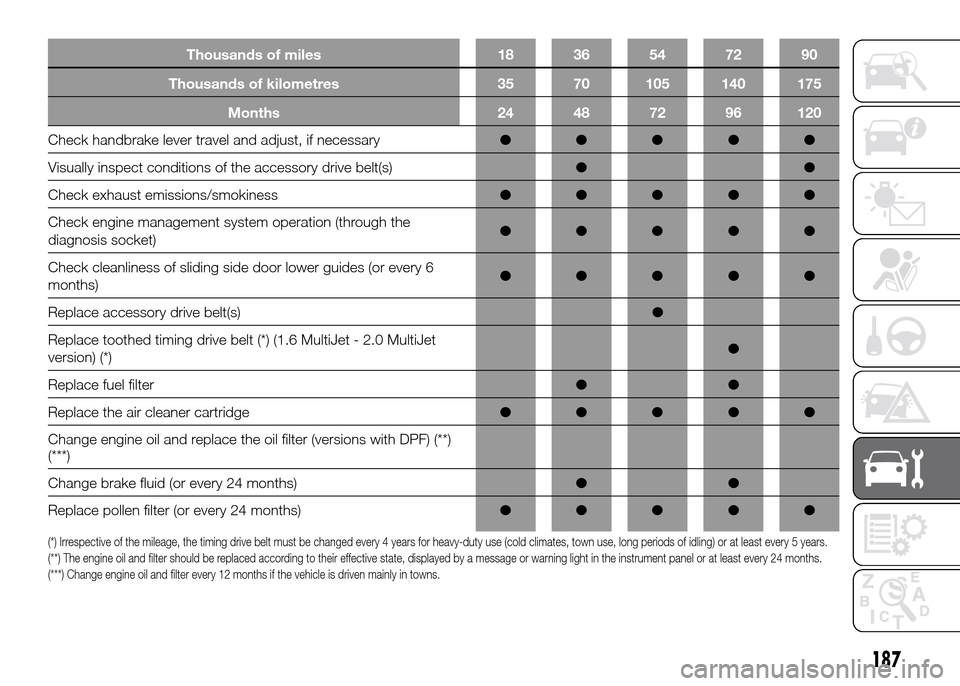
Thousands of miles 18 36 54 72 90
Thousands of kilometres 35 70 105 140 175
Months 24 48 72 96 120
Check handbrake lever travel and adjust, if necessary●●●●●
Visually inspect conditions of the accessory drive belt(s)●●
Check exhaust emissions/smokiness●●●●●
Check engine management system operation (through the
diagnosis socket)●●●●●
Check cleanliness of sliding side door lower guides (or every 6
months)●●●●●
Replace accessory drive belt(s)●
Replace toothed timing drive belt (*) (1.6 MultiJet - 2.0 MultiJet
version) (*)●
Replace fuel filter●●
Replace the air cleaner cartridge●●●●●
Change engine oil and replace the oil filter (versions with DPF) (**)
(***)
Change brake fluid (or every 24 months)●●
Replace pollen filter (or every 24 months)●●●●●
(*) Irrespective of the mileage, the timing drive belt must be changed every 4 years for heavy-duty use (cold climates, town use, long periods of idling) or at least every 5 years.
(**) The engine oil and filter should be replaced according to their effective state, displayed by a message or warning light in the instrument panel orat least every 24 months.
(***) Change engine oil and filter every 12 months if the vehicle is driven mainly in towns.
187
Page 200 of 323
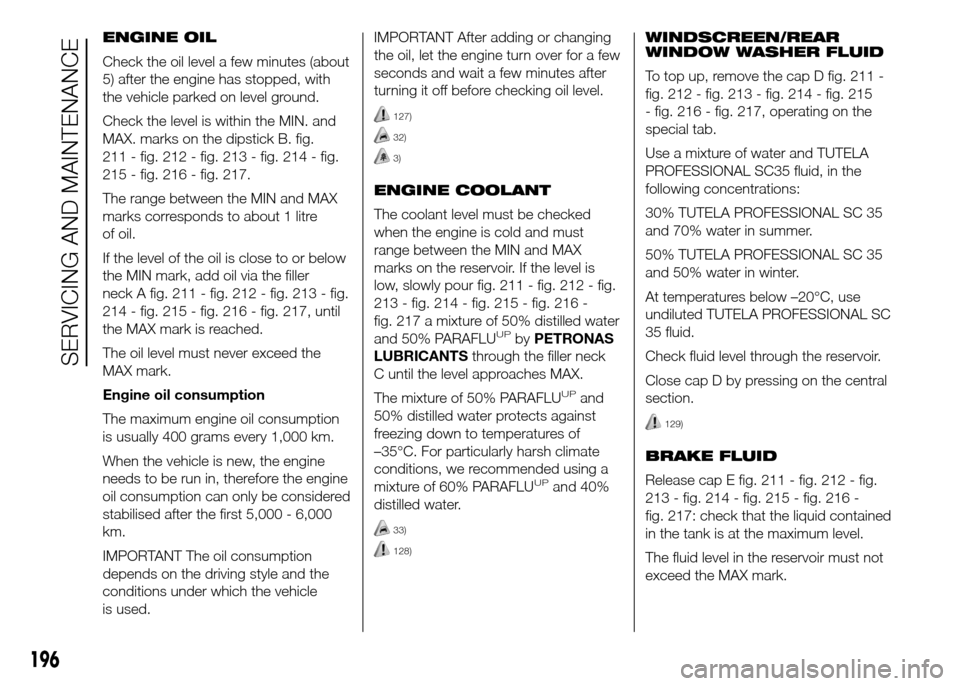
196
SERVICING AND MAINTENANCE
ENGINE OIL
Check the oil level a few minutes (about
5) after the engine has stopped, with
the vehicle parked on level ground.
Check the level is within the MIN. and
MAX. marks on the dipstick B. fig.
211 - fig. 212 - fig. 213 - fig. 214 - fig.
215 - fig. 216 - fig. 217.
The range between the MIN and MAX
marks corresponds to about 1 litre
of oil.
If the level of the oil is close to or below
the MIN mark, add oil via the filler
neck A fig. 211 - fig. 212 - fig. 213 - fig.
214 - fig. 215 - fig. 216 - fig. 217, until
the MAX mark is reached.
The oil level must never exceed the
MAX mark.
Engine oil consumption
The maximum engine oil consumption
is usually 400 grams every 1,000 km.
When the vehicle is new, the engine
needs to be run in, therefore the engine
oil consumption can only be considered
stabilised after the first 5,000 - 6,000
km.
IMPORTANT The oil consumption
depends on the driving style and the
conditions under which the vehicle
is used.IMPORTANT After adding or changing
the oil, let the engine turn over for a few
seconds and wait a few minutes after
turning it off before checking oil level.
127)
32)
3)
ENGINE COOLANT
The coolant level must be checked
when the engine is cold and must
range between the MIN and MAX
marks on the reservoir. If the level is
low, slowly pour fig. 211 - fig. 212 - fig.
213 - fig. 214 - fig. 215 - fig. 216 -
fig. 217 a mixture of 50% distilled water
and 50% PARAFLU
UPbyPETRONAS
LUBRICANTSthrough the filler neck
C until the level approaches MAX.
The mixture of 50% PARAFLU
UPand
50% distilled water protects against
freezing down to temperatures of
–35°C. For particularly harsh climate
conditions, we recommended using a
mixture of 60% PARAFLU
UPand 40%
distilled water.
33)
128)
WINDSCREEN/REAR
WINDOW WASHER FLUID
To top up, remove the cap D fig. 211 -
fig. 212 - fig. 213 - fig. 214 - fig. 215
- fig. 216 - fig. 217, operating on the
special tab.
Use a mixture of water and TUTELA
PROFESSIONAL SC35 fluid, in the
following concentrations:
30% TUTELA PROFESSIONAL SC 35
and 70% water in summer.
50% TUTELA PROFESSIONAL SC 35
and 50% water in winter.
At temperatures below –20°C, use
undiluted TUTELA PROFESSIONAL SC
35 fluid.
Check fluid level through the reservoir.
Close cap D by pressing on the central
section.
129)
BRAKE FLUID
Release cap E fig. 211 - fig. 212 - fig.
213 - fig. 214 - fig. 215 - fig. 216 -
fig. 217: check that the liquid contained
in the tank is at the maximum level.
The fluid level in the reservoir must not
exceed the MAX mark.
Page 205 of 323
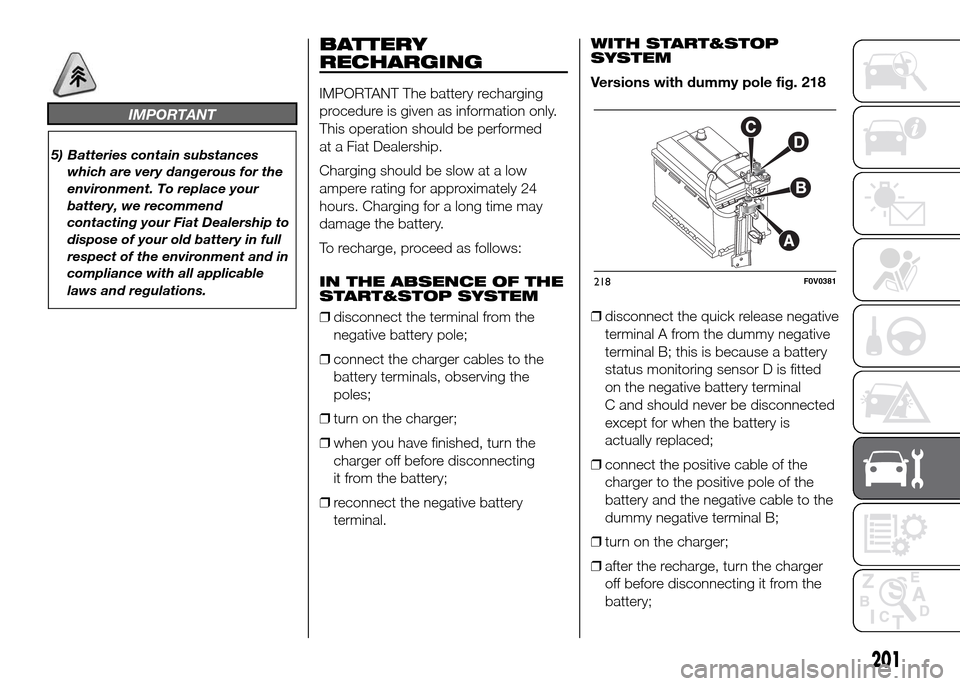
IMPORTANT
5) Batteries contain substances
which are very dangerous for the
environment. To replace your
battery, we recommend
contacting your Fiat Dealership to
dispose of your old battery in full
respect of the environment and in
compliance with all applicable
laws and regulations.
BATTERY
RECHARGING
IMPORTANT The battery recharging
procedure is given as information only.
This operation should be performed
at a Fiat Dealership.
Charging should be slow at a low
ampere rating for approximately 24
hours. Charging for a long time may
damage the battery.
To recharge, proceed as follows:
IN THE ABSENCE OF THE
START&STOP SYSTEM
❒disconnect the terminal from the
negative battery pole;
❒connect the charger cables to the
battery terminals, observing the
poles;
❒turn on the charger;
❒when you have finished, turn the
charger off before disconnecting
it from the battery;
❒reconnect the negative battery
terminal.WITH START&STOP
SYSTEM
Versions with dummy pole fig. 218
❒disconnect the quick release negative
terminal A from the dummy negative
terminal B; this is because a battery
status monitoring sensor D is fitted
on the negative battery terminal
C and should never be disconnected
except for when the battery is
actually replaced;
❒connect the positive cable of the
charger to the positive pole of the
battery and the negative cable to the
dummy negative terminal B;
❒turn on the charger;
❒after the recharge, turn the charger
off before disconnecting it from the
battery;
218F0V0381
201
Page 212 of 323

IMPORTANT Wipe the inside surface of
the rear window gently with a cloth in
the direction of the filaments to avoid
damaging the heater coils.
Engine compartment
At the end of each winter, thoroughly
wash the engine compartment, taking
care to avoid spraying the water jet
directly onto the electronic control units
and the relay/fuse box on the left side
of the engine compartment (driving
direction). Have this operation
performed at a specialised workshop.
IMPORTANT The washing should
take place with the engine cold and the
ignition key in the STOP position. After
the washing operation, make sure
that the various protections (e.g. rubber
caps and guards) have not been
removed or damaged.
Headlights
IMPORTANT Never use aromatic
substances (e.g. petrol) or ketones (e.g.
acetone) for cleaning the plastic lenses
of the front headlights.
IMPORTANT
39) Some car washes with old-style
blades and/or in a poor state of
repair can damage the paintwork,
facilitating the formation of lines
that give the paint a dull/misty
appearance, especially on dark
colours. If this happens, lightly
polish the paintwork with
appropriate products.
IMPORTANT
6) Detergents cause water pollution.
The vehicle should be washed in
areas equipped for collecting
and purifying the liquid used in
the washing process.
INTERIORS
Regularly check that water is not
trapped under the mats (due to water
dripping off shoes, umbrellas, etc.),
as this could cause oxidation of the
sheet metal.
143) 144)
SEATS AND FABRIC
PARTS
Remove dust with a soft brush or a
vacuum cleaner. It is advisable to use a
moist brush on velvet upholstery.
Rub the seats with a sponge moistened
with a solution of water and mild soap.
PLASTIC PARTS
It is advisable to clean interior parts with
a moist cloth and a solution of water
and non-abrasive mild soap. Use
specific products for cleaning plastic,
without solvents and specifically
designed to prevent damage to the
appearance and colour of the treated
parts, to remove grease and tough
stains.
IMPORTANT Do not use alcohol,
petrols or their derivatives to clean the
instrument panel glass.
208
SERVICING AND MAINTENANCE
Page 216 of 323
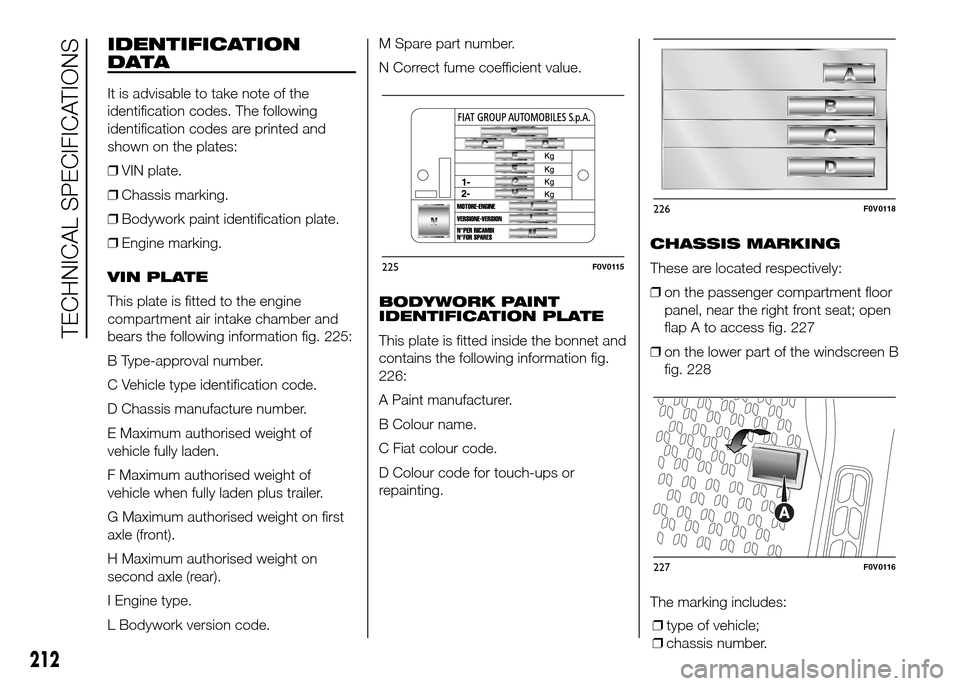
IDENTIFICATION
DATA
It is advisable to take note of the
identification codes. The following
identification codes are printed and
shown on the plates:
❒VIN plate.
❒Chassis marking.
❒Bodywork paint identification plate.
❒Engine marking.
VIN PLATE
This plate is fitted to the engine
compartment air intake chamber and
bears the following information fig. 225:
B Type-approval number.
C Vehicle type identification code.
D Chassis manufacture number.
E Maximum authorised weight of
vehicle fully laden.
F Maximum authorised weight of
vehicle when fully laden plus trailer.
G Maximum authorised weight on first
axle (front).
H Maximum authorised weight on
second axle (rear).
I Engine type.
L Bodywork version code.M Spare part number.
N Correct fume coefficient value.
BODYWORK PAINT
IDENTIFICATION PLATE
This plate is fitted inside the bonnet and
contains the following information fig.
226:
A Paint manufacturer.
B Colour name.
C Fiat colour code.
D Colour code for touch-ups or
repainting.CHASSIS MARKING
These are located respectively:
❒on the passenger compartment floor
panel, near the right front seat; open
flap A to access fig. 227
❒on the lower part of the windscreen B
fig. 228
The marking includes:
❒type of vehicle;
225F0V0115
226F0V0118
227F0V0116
212
TECHNICAL SPECIFICATIONS
❒chassis number.
Page 220 of 323
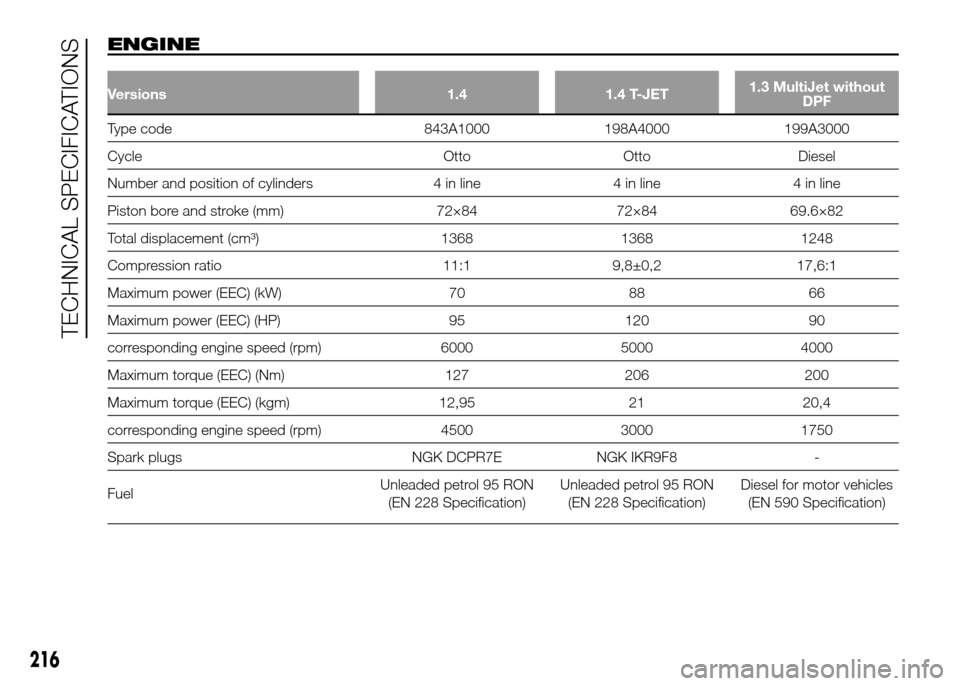
ENGINE
Versions 1.4 1.4 T-JET1.3 MultiJet without
DPF
Type code 843A1000 198A4000 199A3000
Cycle Otto Otto Diesel
Number and position of cylinders 4 in line 4 in line 4 in line
Piston bore and stroke (mm) 72×84 72×84 69.6×82
Total displacement (cm³) 1368 1368 1248
Compression ratio 11:1 9,8±0,2 17,6:1
Maximum power (EEC) (kW) 70 88 66
Maximum power (EEC) (HP) 95 120 90
corresponding engine speed (rpm) 6000 5000 4000
Maximum torque (EEC) (Nm) 127 206 200
Maximum torque (EEC) (kgm) 12,95 21 20,4
corresponding engine speed (rpm) 4500 3000 1750
Spark plugs NGK DCPR7E NGK IKR9F8 -
FuelUnleaded petrol 95 RON
(EN 228 Specification)Unleaded petrol 95 RON
(EN 228 Specification)Diesel for motor vehicles
(EN 590 Specification)
216
TECHNICAL SPECIFICATIONS
Page 221 of 323

Versions 1.3 MultiJet with DPF1.6 MultiJet Euro 4 /
Euro 5 / Euro 5+1.6 Multijet Euro 6
Engine code 263A2000 / 263A6000198A3000 / 263A3000 /
263A4000 / 263A5000940C1000 / 263A8000 /
263A7000
Cycle Diesel Diesel Diesel
Number and position of cylinders 4 in line 4 in line 4 in line
Piston bore and stroke (mm) 69.6x82 79.5x80.5 79.5x80.5
Total displacement (cm³) 1248 1598 1598
Compression ratio 16.8:1 16.5:1 16.5+-0.4
Maximum power (EC) (kW) 66/55 77/74/66 88/77/70
Maximum power (EC) (HP) 90/75 105/100/90 120/105/95
corresponding engine speed (rpm) 4000 4000 3750/3750/2500
Maximum torque (EC) (Nm) 200 290/200(*) 320/300/300
Maximum torque (EC) (kgm) 20.4 29.6/20.4(*) 32.6/30.6/30.6
corresponding engine speed (rpm) 1500 1500 1750
Spark plugs - - -
FuelDiesel for motor vehicles
(EN 590 Specification)Diesel for motor vehicles
(EN 590 Specification)Diesel for motor vehicles
(EN 590 Specification)
(*) Engine code 263A5000
217
Page 222 of 323
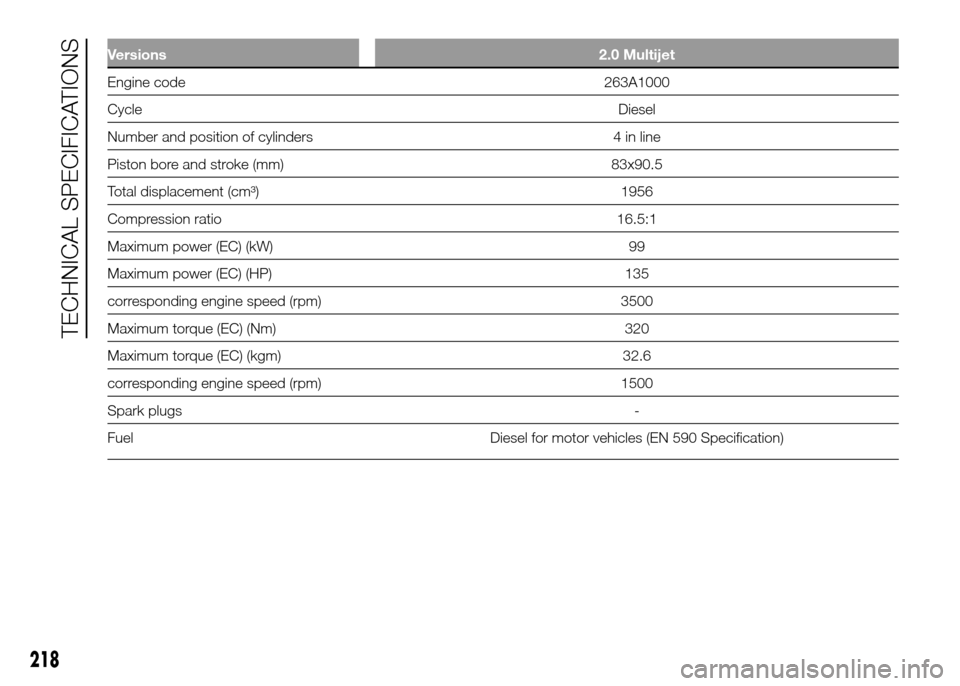
Versions 2.0 Multijet
Engine code 263A1000
CycleDiesel
Number and position of cylinders 4 in line
Piston bore and stroke (mm) 83x90.5
Total displacement (cm³) 1956
Compression ratio 16.5:1
Maximum power (EC) (kW) 99
Maximum power (EC) (HP) 135
corresponding engine speed (rpm) 3500
Maximum torque (EC) (Nm) 320
Maximum torque (EC) (kgm) 32.6
corresponding engine speed (rpm) 1500
Spark plugs -
Fuel Diesel for motor vehicles (EN 590 Specification)
218
TECHNICAL SPECIFICATIONS
Page 229 of 323
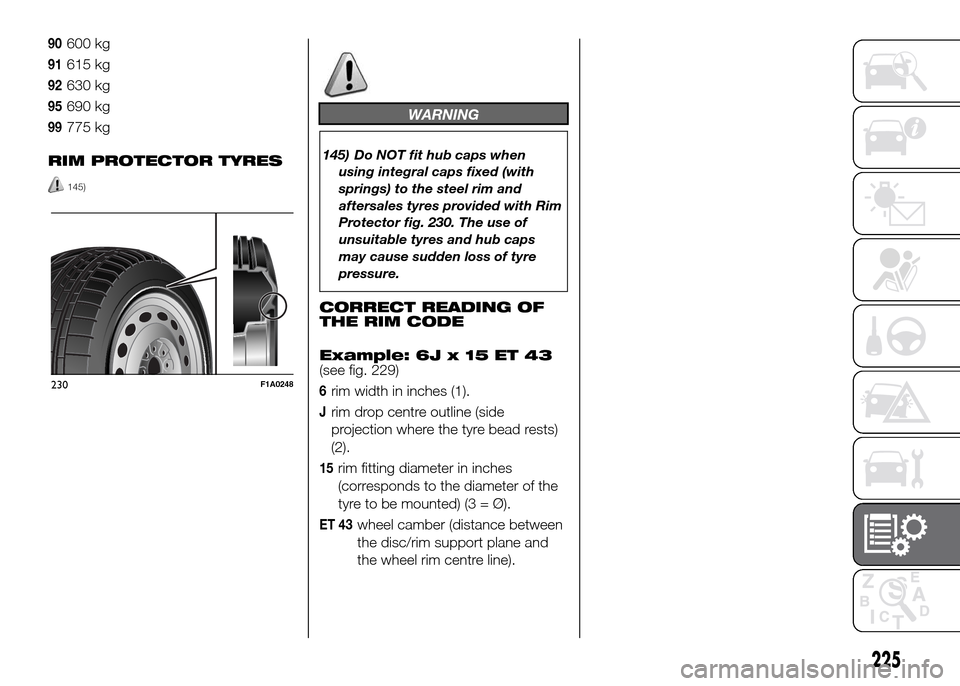
90600 kg
91615 kg
92630 kg
95690 kg
99775 kg
RIM PROTECTOR TYRES
145)
WARNING
145) Do NOT fit hub caps when
using integral caps fixed (with
springs) to the steel rim and
aftersales tyres provided with Rim
Protector fig. 230. The use of
unsuitable tyres and hub caps
may cause sudden loss of tyre
pressure.
CORRECT READING OF
THE RIM CODE
Example: 6J x 15 ET 43
(see fig. 229)
6rim width in inches (1).
Jrim drop centre outline (side
projection where the tyre bead rests)
(2).
15rim fitting diameter in inches
(corresponds to the diameter of the
tyre to be mounted) (3 = Ø).
ET 43wheel camber (distance between
the disc/rim support plane and
the wheel rim centre line).
230F1A0248
225
Page 241 of 323
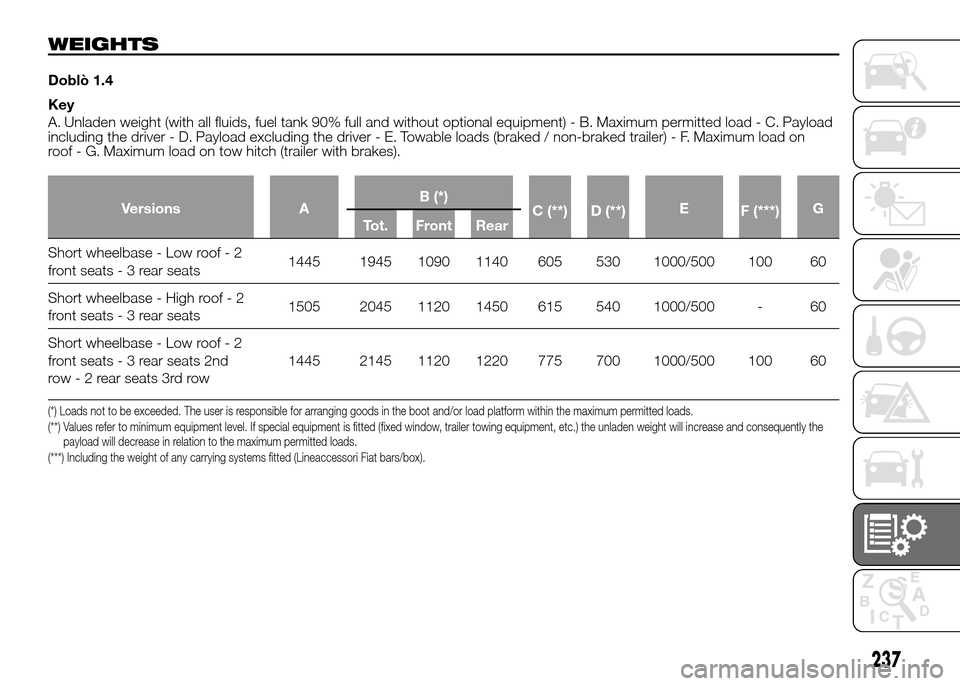
WEIGHTS
Doblò 1.4
Key
A. Unladen weight (with all fluids, fuel tank 90% full and without optional equipment) - B. Maximum permitted load - C. Payload
including the driver - D. Payload excluding the driver - E. Towable loads (braked / non-braked trailer) - F. Maximum load on
roof - G. Maximum load on tow hitch (trailer with brakes).
Versions AB (*)
C (**) D (**)E
F (***)G
Tot. Front Rear
Short wheelbase - Low roof - 2
front seats-3rearseats1445 1945 1090 1140 605 530 1000/500 100 60
Short wheelbase - High roof - 2
front seats-3rearseats1505 2045 1120 1450 615 540 1000/500 - 60
Short wheelbase - Low roof - 2
front seats-3rearseats 2nd
row-2rearseats 3rd row1445 2145 1120 1220 775 700 1000/500 100 60
(*) Loads not to be exceeded. The user is responsible for arranging goods in the boot and/or load platform within the maximum permitted loads.
(**) Values refer to minimum equipment level. If special equipment is fitted (fixed window, trailer towing equipment, etc.) the unladen weight will increase and consequently the
payload will decrease in relation to the maximum permitted loads.
(***) Including the weight of any carrying systems fitted (Lineaccessori Fiat bars/box).
237